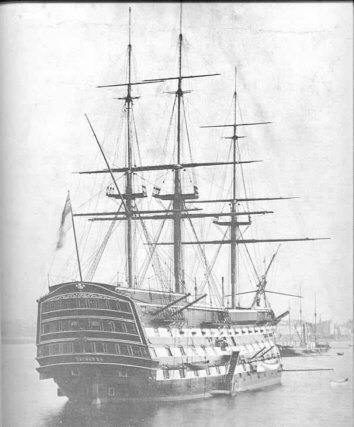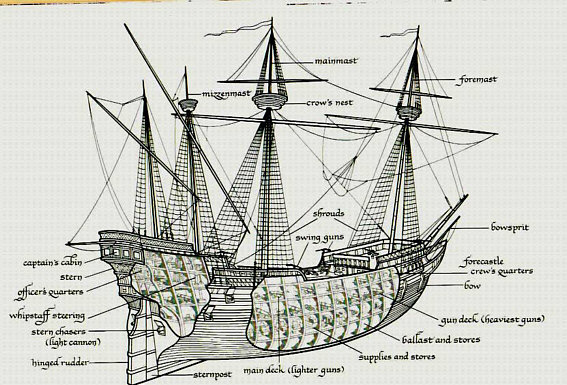Caribbean Tales - Ships -
Man-O-War/Ship-of-The-Line


These ships were the "heavy-guns"
of the fleet. They resembled galleons in design, but sported heavy fire-power
with an average of 65 guns. It was not uncommon to have over 100 guns. They
were around 1,000 tons and had 3 masts, which were square-rigged, except for
a lateen sail on her aft-mast. Only the three major sea-powers of the time
(Spain, England, and France) had an extensive use of these ships.
The Man-O-War is a naval ship that was designed for combat and not for merchant
service. It was typically heavily armed and often avoided by the pirates.
Of course sometimes such ship were used to transport treasure or acted as
escort to merchant ships. Also the ships would be deployed strategically just
beyond the horizon or in the shadow of merchant ships as a trap for would
be pirates. While most pirates avoided tangling with the Man-O-Wars, Bartholmew
Roberts was known for not making such a fine distinction and would often tangle
which such ships if he knew they were carrying a substantial prize.
There are three general classes of Man-O-Wars.
Ship of the Line
The Ship of the Line is the main battle ship of a Navy and the largest of
the Man-O-Wars. It was ship rigged with three masts. Its guns were arranged
on three gun decks. Depending on the time period Ships of the line carried
between 32 and 144 guns arranged on three and sometimes four decks. This is
because they continued to get larger from the 16th to 18th century. By the
mid-18th century the typical ship of the line had 74 guns on three decks.
Sometimes a smaller Ship of the line would have
its guns on just two gun decks instead of the more traditional three. The
larger ships of the line at this time, two deckers carry 50-60 guns would
soon be eclipsed and relegated to escort & hunting duties by the end of
the 1700's. Typically the cannons were around 32 to 42 pounders. The Galleon,
for all practical purposes is also a Man-O-War and was Spain's Ship of the
Line.
For the most part they were not terrific sailing ships and clumsy to manouvre
in battle. The three deck ships were by far the more clumsy, and in time large
two deckers were replacing them as the main ship of the line. Ships of the
line were more suited to fighting other ships of the same style. In the Caribbean,
ships of the line did not appear in this time period. Naval ships didn't rise
above 40 guns, and most of the pirate hunting was done of vessels up to 20
guns, most work being done on war sloops or hired merchant sloops with 10
guns or so.
Frigate
The Frigate was the midsized Man-O-War, It was still ship rigged with three
masts but was noticably smaller than a Ship of the Line. It would typically
have a full battery of guns on the gun deck and a light battery on a spar
deck. Typically the Frigate would carry between 24 and 40 guns ranging in
size between 12 and 24 pounders.
Corvette (Sloop of War)
The Corvette was typically "Brig Rigged" with only two masts.
It is sometime called a "Sloop of War" but should not be confused
with an actual sloop. Corvettes had their guns arranged on a single fighting
deck. A typical corvette would carry between 12 to 20 guns ranging between
6 to 12 pounders. As the ships become less
well armored its abiltiy to manuever increases. So this would make the Corvette
a fast light ship that could attack quickly but not bring an enormous amount
of fire power to hand.
